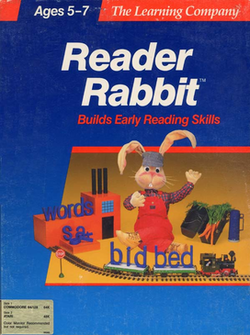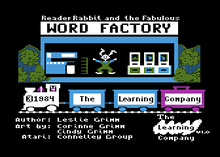Reader Rabbit (video game)
 From Wikipedia the free encyclopedia
From Wikipedia the free encyclopedia
| Reader Rabbit | |
|---|---|
 C64/Atari cover art | |
| Developer(s) | The Learning Company The Connelley Group (Atari 8-Bit)[1] |
| Publisher(s) | The Learning Company |
| Series | Reader Rabbit |
| Platform(s) | Original: Apple II, Apple IIGS, Atari 8-Bit, Commodore 64, DOS, Macintosh Talking: Windows, Macintosh |
| Release | 1984 (Original) 1989 (Talking) 1991 (Reader Rabbit 1) 1994 (Deluxe) 1997 (Reading 1) |
| Genre(s) | Edutainment |
| Mode(s) | Single-player |
Reader Rabbit (fully titled "Reader Rabbit and the Fabulous Word Factory" or alternatively known as "Reader Rabbit Builds Early Learning & Thinking"[2]) is a 1984 video game and the first of the long-running Reader Rabbit edutainment series. It was made by The Learning Company for Apple II and later for other computers. It also made use of the KoalaPad graphics tablet.[3] The Connelley Group helped with the Atari 8-Bit conversion in 1984.[1] A Talking version was developed for the Apple IIGS in 1989. An enhanced version was released for DOS on 1991. A Deluxe version was released in 1994 for Macintosh and Windows 3.x. In 1997, the game was remade for Windows and Macintosh under the title "Reader Rabbit's Reading 1".
Development[edit]

Reader Rabbit was originally conceived by the Grimm sisters; Leslie authored the game while Corinne and Cindy contributed the art. Version 1.0 of Reader Rabbit, titled Reader Rabbit and the Fabulous Word Factory, was released in early 1984[4] (and featured in the 1983 holiday special for Computer Chronicles[5]), while versions 1.1, 1.2 and 1.3 were released in 1984.[6][7] Development for an updated 2.0 version began at the start of 1984. By this time, Leslie Grimm had suffered a disc fracture but was able to develop the game while bedridden, thanks to a detachable keyboard provided by her colleague Pete Rowe.[8] Many critics and gaming historians erroneously assert that the Reader Rabbit series officially began in 1986.[9]
In 1988, the first "talking" version of Reader Rabbit was released for the Apple IIGS and Tandy 1000 computers.[10] The game was remade as an enhanced version for DOS in 1991 to incorporate the 256-color VGA mode, sound card option and mouse compatibility.[11] Another remake was done as a deluxe version along with its two sequels and implemented digitized speech.[12]
Gameplay[edit]
The game takes place in the titular Word Factory, which teaches reading and spelling in four different activities and has over 200 three-letter words and more than 70 pictures for learning.[2][13] The following four activities are:
- 1. Sorter - the player is required to pick words that start with a chosen letter and discard the rest.
- 2. Labeler - out of a number of mixed up letters, the player must use those letters to spell words that match three objects on the screen.
- 3. Word Train - the player needs to select a word that slightly differs from the first.
- 4. Matchup Games - the player must match picture cards with corresponding word cards.
Reception[edit]
| Publication | Award |
|---|---|
| Newsweek | Editors' Choice Award, 1995 (Deluxe)[14] |
| Gold Medal | National Association of Parenting Publications, 1994 (Deluxe)[14] |
| Reseller Management | "Best to Sell" Software Product - Education, 1992 (Reader Rabbit 1)[14] |
| Program of the Decade | Language Arts, Technology & Learning, 1991 (Reader Rabbit 1)[14] |
| Parents' Choice | Best Software of the Year, 1987 (Original)[14] |
| Family Computing | Critics' Choice Award, 1985 (Original)[14] |
The Learning Company showcased the game alongside Number Stamper, Word Spinner, Addition Magician and Colorasaurus in the 1984 Winter Consumer Electronics Show.[13] Dr. Ann Piestrup praised the game for its ability to aid young learners in overcoming the difficulties of reading and its word recognition.[15]
References[edit]
- ^ a b "Atari Mania - Reader Rabbit". Retrieved March 5, 2017.
- ^ a b Brett Alan Weiss. "Reader Rabbit - Review - allgame". Allgame. Archived from the original on November 15, 2014. Retrieved March 5, 2017.
- ^ ""Reader Rabbit and the Fabulous Word Factory" Manual". The Learning Company. 1984: 11. Retrieved March 5, 2017.
{{cite journal}}: Cite journal requires|journal=(help) - ^ Leslie Grimm (1984-01-01), Reader Rabbit 1.1, The Learning Company, retrieved 2017-02-06
- ^ Bradley, Laura (2014-11-28). "Tech Time Capsule". Slate. ISSN 1091-2339. Retrieved 2017-02-06.
- ^ Mace, Scott; Caruso, Denise (February 13, 1984). "TLC shows off additions to firm's educational line". InfoWorld. InfoWorld Media Group, Inc. p. 40.
- ^ Reader Rabbit 1.3 (4am crack), 2015-07-14, retrieved 2017-02-06
- ^ "Softalk, Volume 4". Softalk. January 1984. p. 65. Retrieved February 2, 2017.
- ^ "10 Educational PC Games of the 1980s". PCMAG. Archived from the original on 2017-02-07. Retrieved 2017-02-15.
- ^ "Educational software now receiving higher marks". 1988-01-10. Archived from the original on 2017-02-07.
{{cite journal}}: Cite journal requires|journal=(help) - ^ "Reader Rabbit Redux". PCMAG. 31 December 1991. Retrieved 2018-01-31.
- ^ "Reader Rabbit 1 Features". The Learning Company. Archived from the original on February 25, 1997. Retrieved February 1, 2018.
{{cite web}}: CS1 maint: bot: original URL status unknown (link) - ^ a b Staples, Betsy (April 1984). "Getting educated at CES; educational software crowds the show floor". Creative Computing. Vol. 10, no. 4. Ziff Davis. p. 154.
- ^ a b c d e f "Reader Rabbit 1 Awards". The Learning Company. Archived from the original on February 25, 1997. Retrieved February 1, 2018.
{{cite web}}: CS1 maint: bot: original URL status unknown (link) - ^ Mace, Scott; Caruso, Denise (February 13, 1984). "TLC shows off additions to firm's educational line". InfoWorld. No. 13. IDG. p. 40.